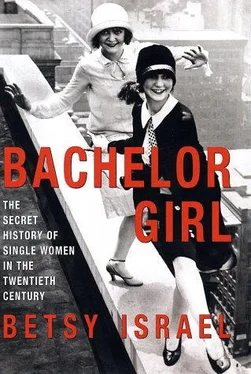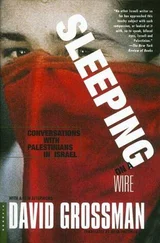CHAPTER 4: THE SUSPICIOUS SINGLE
Susan Ware, Holding Their Own: American Women in the 1930s (Boston, Twayne, 1982); Joan Hoff-Wilson and Marjorie Lightman, Without Precedent: The Life and Career of Eleanor Roosevelt (Bloomington: University of Indiana Press, 1984); Anne Hirst, Get and Hold Your Man (New York: Kinsey, 1937); Don Congdon, ed., The Thirties: A Time to Remember (New York: Simon & Schuster, 1962); Ben L. Reitman, Sister of the Road: The Autobiography of Box-Car Bertha (New York: Sheridan House, 1937); Susan M. Hartmann, The Homefront and Beyond: American Women in the 1940s (Boston, Twayne, 1982); Karen Anderson, Wartime Women: Sex Roles, Family Relations and the Status of Women During World War II (Westport, Conn.: Greenwood Press, 1981); Sherna Berger Gluck, Rosie the Riveter Revisited: Women, the War and Social Change (Boston: Meridien, 1987) includes oral histories of women in all areas of the war industries; Maureen Honey, Creating Rosie the Riveter: Class, Gender, and Propaganda During World War II (Amherst: University of Massachusetts Press, 1984); Ferdinand Lundberg and Marynia Farnham, Modern Woman: The Lost Sex (New York: Harper & Row, 1947); Elizabeth Hawes, Anything but Love: A Complete Digest of the Rules for Feminine Behaviour from Birth to Death, Given Out in Print, On Film, and Over the Air, Read, Seen, Listened to Monthly by Some 340,000,000 American Women (New York: Rinehart, 1948).
Periodicals:
Mabel Barbee Lee, “The Dilemma of the Educated Woman,” Atlantic (Dec. 1930); Genevieve Parkhurst, “Is Feminism Dead?” Harper’s (1935); “Anxious Ladies: To Be Wed) or Not to Be,” Mademoiselle (1938); Juliet Farnham, “How to Meet Men and Marry,” book excerpt, McCall’s (1943); “Somebody’s After Your Man!” Good House keeping (Aug., 1945); “In Marriage, It’s a Man’s Market!” New York Times Magazine (June 17, 1945); “Your Chances of Getting Married,” Good Housekeeping (Oct. 1946); “U.S. Marriage Rate Zooms to All-Time High,” Science Digest (Oct. 1947); “How Feminine Are You to Men?” Women’s Home Companion (May 1946); “No Date Is No Dis grace,” Women’s Home Companion (Nov. 1946); George Lawton, “Proof That She Is the Stronger Sex,” New York Times Magazine (Dec. 12, 1948); “The Unwilling Virgins,” Es quire (May 1949); “The High Cost of Dating,” Ladies’ Home Journal (Sept. 1949).
Advice/conduct guides:
Steven Hart and Lucy Brown, How to Get Your Man and Hold Him (New York: Dover, 1944); Cora Carle, How to Get a Husband (New York: Hedgehog Press, 1949); Jean and Gene Berger, Win Your Man and Keep Him (Chicago: Windsor Press, 1948); Judson T. and Mary G. Landis, Building a Successful Marriage (Englewood Cliffs, N.J.: Prentice-Hall, 1948).
On the emergence of bobby-soxers, see This Fabulous Century: 1940–50 (New York: Time-Life, 1969).
CHAPTER 5: THE SECRET SINGLE
Alfred Kinsey, Sexual Behavior in the Human Female (Philadelphia: Saunders, 1953); David Reisman, The Lonely Crowd, 2d ed. (Cambridge: Harvard University Press, 1964); C. Wright Mills, White Collar: The American Middle Class (New York: Oxford University Press, 1951); Mirra Komarovsky, Women in the Modern World: Their Education and Dilemmas (Boston: Little, Brown, 1953); Lawrence and Mary Frank, How to Be a Woman (Indianapolis: Bobbs-Merrill, 1954); Norman Hamilton, How to Woo and Keep Your Man (New York: William Fredericks, 1955); Robert O. Blood, Anticipating Your Marriage, the classic marriage text (New York: Free Press, 1957); Nicholas Drake, The Fifties in VOGUE (New York: Henry Holt, 1987); Rona Jaffe, The Best of Every thing (1958; New York: Avon, 1976); Joyce Johnson, Minor Characters: A Young Woman’s Coming of Age in the Beat Generation (New York: Washington Square, 1983); Herman Wouk, Marjorie Morningstar (Garden City, N.Y.: Doubleday, 1955); Winnie Dienes, Young, White and Miserable: Growing Up in the 1950s (Boston: Beacon Press, 1992); J. D. Salinger, Franny and Zooey (Boston: Little, Brown, 1961).
Periodicals:
“What You Should Know About Women, Even if You’re a Woman,” Collier’s (Nov. 1951); “No Right Age for a Girl to Marry,” New York Times (Oct. 19, 1952); Patty DeRoulf, “Must Bachelor Girls Be Immoral?” Coronet (Feb. 9, 1952); “Her First Date,” Look, (Dec. 1953); Juliet Tree, “When a Girl Lives Alone,” Good Housekeeping (Mar. 1953); “ Life Calls on Seven Spinsters,” Life (June 8, 1953), in which Life went out and found spinsters as it might earlier have found the Dionne quints (seven sisters, thirty-eight to fifty-one, all wait on Dad and dress alike—quirky Mousketeer sensibility or psychopathology?); “How to Be Marriageable,” Ladies’ Home Journal (Mar. 1954); James A. Skardon, “Room, Board and Romance,” a series on new coed board inghouses in San Francisco, New York Herald Tribune (Oct. 20, 1954); “Is Marriage the Trap?” Mademoiselle (Dec. 1955); Anita Colby, “In Defense of the Single Woman,” Look (Nov. 29, 1955); “The Date Line,” Good Housekeeping (Oct. 1956); “Some Persons Should Stay Single,” Science Digest (May 1956); Life Magazine Special Issue on “The American Woman,” Life (Dec. 24, 1956); Polly Weaver, “What’s Wrong with Ambition?” Mademoiselle (Sept. 1956); “Will Success Spoil American Women?” New York Times Magazine (Nov. 10, 1957); Gael Greene, “Lone Women,” series, New York Post (Nov. 18–Dec. 1, 1957); Earl Ubell, “Pressure and Tension Beset the Lone Woman,” New York Herald Tribune (Dec. 6, 1957); James H. S. Brossard, “The Engagement Ring: A Changing Symbol” New York Times Magazine (July 14, 1958); Gloria Emerson, “The Lives of a New York Career Girl” Holiday (May 1958); “If You Don’t Go Steady, You’re Different,” Ladies’ Home Journal (Dec. 1959); “Bachelor Girls—They Play by Their Own Rules,” five-part series, New York Daily News (Apr. 1959).
Novels:
Gail Parent, Sheila Levine Is Dead and Living in New York; (New York: Putnam, 1972) Judith Rossner, Looking for Mr. Goodbar (New York: Simon & Schuster, 1975); Erica Jong, Fear of Flying (1973; New York: NAL, 1995); Mary Gordon, Final Payments (New York: Ballantine, 1978).
CHAPTER 6: THE SWINGING SINGLE
Books:
Helen Gurley Brown, Sex and the Single Girl (New York: Bernard Geiss/Random House, 1962); Betty Friedan, The Feminine Mystique (1963; New York: Dell, 1973); Charles Abrams, The City Is the Frontier (New York: Columbia University Press, 1965); Joan Didion, Something Toward Bethlehem (New York: Farrar, Straus & Giroux, 1968); Howard Bahr and Gerald Garrett, Women Alone: The Disaffiliation of Urban Females (Lexington, Mass.: Lexington Books, 1976); Suzanne Gordon, Lonely in America (New York: Simon & Schuster, 1976); Jean Baker Miller, Toward A New Psychology of Women (Boston: Beacon Books, 1979).
Periodicals:
Joan Didion, “The Great Reprieve,” Mademoiselle (June 1960); “Do Women Provoke Sex Attack?” Cosmopolitan (Mar. 1960); “The Non-Woman, A Manhattan Enigma, Cosmopolitan (Mar. 1960); Sylvia Porter, “Women Alone,” New York Post (Sept. 13, 1960); Carol Taylor, “East Side, West Side, They Flock to New York for Job, Dream, Dream Man,” New York World-Telegram (Jan. 3, 1960); “Go West Young Woman if You Wish to Wed,” New York Herald Tribune (May 10, 1961); Phyllis Rosenteur, “Unwed Woman a Likely Cynic,” ( Newsweek, book excerpt, May 1962); Gloria Steinem, “The Moral Disarmament of Betty Co-ed,” Esquire (Sept. 1962); “How Nice to Be a Pretty Girl in Washington, D.C.,” Life (Mar. 23, 1962); Marion K. Sanders, “The Case of the Vanishing Spinster,” New York Times Magazine (Sept. 22, 1963); “Two Girls Murdered in E. 88th St. Flat,” New York Times, (Aug. 29, 1963); Nan Robertson, “Where the Boys Are Not: At the Barbizon,” New York Times (Oct. 19, 1963); on Kitty Genovese, Loudon Wainwright, “The Dying Girl That Nobody Helped,” Life (Apr. 10, 1964); Sylvia Porter, “Girls Without Jobs,” New York Post (Mar. 25, 1965); Nina McCain, “New York and the Single Girl!” New York World-Telegram (Dec. 14, 1965); “Cities and the Single Girl,” Newsweek (Nov. 15, 1965); “Students in the Free Sex Movement,” Time (Mar. 11, 1966); Judith Viorst and Dorothy Gilliam, “Washington and the Single Girl,” Washington Post (June 22, 1966); “Where the Singles Are!” Newsweek (Sept. 26, 1966); Douglas Sefton, “The Girl Ghetto: East Side, West Side, Gals Buoying It Up on Broads-way,” New York Daily News (May 10, 1967); “New Rules for the Singles Game,” Life (Aug. 18, 1967); “The Pleasures and Pain of the Single Life,” Time (Sept. 15, 1967); Jean Baer, “The Single Girl in the City,” New York Post (Sept. 21, 1968); Shelby Coffey III, “Single Style Yesterday and Today,”’ Washington Post (Jan. 14, 1968); Christina Mirk, “Mingle but Stay Single!” Sunday Daily News (Mar. 23, 1969); “The Politics of Sex: Who’s Come a Long Way, Baby?” Time. (Aug. 31, 1970); Jon Nordheimer, “Vacation and the Single Girl: Tireless Pursuit of a Dream,” New York Times (July 29, 1970); “A Very Nice Kind of Ski Bum,” Life pictorial on single girls, living together in Aspen (Mar. 8, 1971); “Gloria Steinem: A Liberated Woman Despite Beauty, Chic and Success” Newsweek (Aug. 16, 1971); see also “The Thinking Man’s Jean Shrimpton,” Time (Jan. 3, 1969); Judy Klemesrud, “Single Women Against a Dangerous City,” New York Times (Jan. 12, 1973); Grace Lichtenstein, “Slain Woman’s Neighbors Express Both Horror and Detachment,” New York Times (Oct. 25, 1973); Leslie Maitland, “The Singles Scene Has Sordid Side,” New York Times (Nov. 1, 1974); Susan Jacoby, “Forty-nine Million Singles Can’t All Be Right,” New York Times Magazine (Feb. 17, 1974); Gloria Emerson, “In a City of Crowds, So Many Lonely Women,” New York Times (Jan. 28, 1974); Wendy Shulman, “Singles Becoming More Stable Tenants,” New York Times (July 1974); Judy Klemesrud, “Bachelor’s Life: Things Aren’t Always Hunky-Dory in Paradise,” New York Times (May 3, 1974), “Margaret Mead Puts Single Life in Perspective,” New York Times (Jan. 25, 1974), and “They Tell How They Feel About Being Single Women,” New York Times (Dec. 1974); Robert J. Levin and Amy Levin, “Sexual Pleasure: The Surprising Preferences of 100,000 Women,” Redbook (Sept. 1975); “Men Bite Back,” New York Times (Aug. 1978), a response to Nan Robertson’s controversial essay “Single Women Over 30: Where Are the Men Worthy of Us?” (to quote from one typical male subject: “I am bored with women who claim all that liberation, self-realization, self-fulfillment pap and blame all the woes of women since Eve on me.”); John Kifner, “Hospital at Last Identifies Its Shopping Bag Lady,” New York Times (Jan. 10, 1979).
Читать дальше












